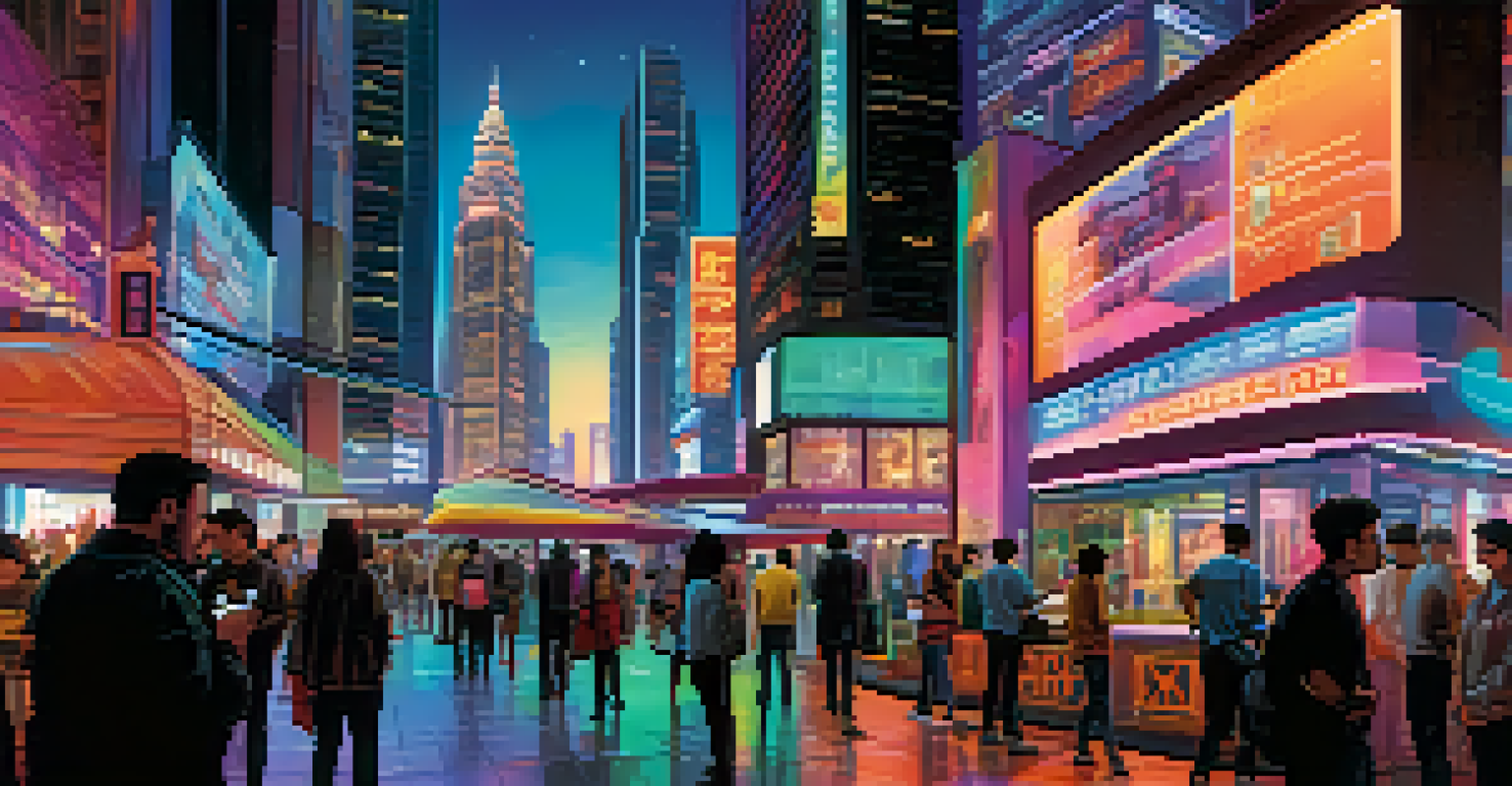Interactive Storytelling: Blending Art with Technology

Understanding Interactive Storytelling and Its Origins
Interactive storytelling is a captivating blend of narrative and user engagement. Unlike traditional storytelling, where the audience passively consumes content, this approach invites them to actively participate in the unfolding story. It has roots in ancient forms of storytelling but has evolved dramatically with advancements in technology.
Interactive storytelling allows the audience to become a part of the narrative, making their choices matter.
The digital age has brought forth tools that allow storytellers to create immersive experiences. Think of video games that allow you to make choices that impact the storyline or interactive films that change direction based on viewer input. These elements enhance emotional engagement, making the narrative feel more personal and impactful.
As we delve deeper into the digital landscape, the possibilities for interactive storytelling continue to expand. From virtual reality (VR) experiences to augmented reality (AR) applications, technology opens new doors for creativity, allowing storytellers to craft experiences that were once unimaginable. The intersection of art and technology is reshaping how we tell stories.
The Role of Technology in Shaping Narratives
Technology plays a pivotal role in transforming how stories are told and experienced. It offers tools such as artificial intelligence (AI) that can adapt narratives based on user choices, creating a dynamic storytelling environment. This not only enhances engagement but also allows for multiple storylines to coexist within a single framework.

For instance, imagine a story where your decisions influence the fate of characters in real time. This level of interactivity encourages deeper emotional connections, as users feel their choices hold weight. The use of algorithms can analyze user behavior, tailoring the experience to fit their preferences and enhancing overall satisfaction.
Interactive Storytelling Engages Users
This approach transforms audiences from passive viewers to active participants, enhancing emotional connections with the narrative.
Moreover, technology facilitates collaboration among artists, writers, and developers, fostering a rich creative ecosystem. By blending different skill sets, teams can create multifaceted narratives that resonate with a wider audience. This synergy between technology and storytelling is what makes interactive storytelling so compelling.
Examples of Successful Interactive Storytelling
Several notable examples illustrate the power of interactive storytelling, with video games leading the charge. Titles like 'The Walking Dead' and 'Life is Strange' allow players to make choices that shape the narrative, resulting in different outcomes. These games not only entertain but also evoke strong emotional responses, demonstrating the depth of storytelling possible through interactivity.
The future of storytelling lies in the hands of those who dare to blend technology with creativity.
Beyond gaming, platforms like Netflix have ventured into the realm of interactive films, such as 'Black Mirror: Bandersnatch.' Viewers can make choices that influence the direction of the plot, showcasing how traditional media can adapt to new storytelling methodologies. This innovation has garnered significant attention and engagement from audiences worldwide.
These examples highlight the versatility of interactive storytelling across various mediums. They serve as a testament to the creativity and innovation that arise when art and technology intertwine. As more creators embrace this concept, we can expect an exciting future filled with diverse storytelling experiences.
The Impact of User Engagement on Storytelling
User engagement is a cornerstone of interactive storytelling, transforming passive viewers into active participants. This shift in engagement not only enhances the storytelling experience but also allows for deeper connections with characters and narratives. When users feel invested, they are more likely to remember and resonate with the story long after the experience ends.
One of the most intriguing aspects of user engagement is its ability to foster community. As users share their experiences and choices, they create discussions around the narrative, often leading to fan theories and interpretations. This communal aspect enriches the storytelling landscape, creating a shared experience that transcends individual interactions.
Technology Enhances Narrative Depth
Advancements like AI and VR allow for dynamic storytelling experiences where user choices significantly impact the plot.
Moreover, the feedback loop created through user engagement can inform future storytelling endeavors. Creators can analyze how audiences react to different elements, shaping the evolution of narratives. This adaptability is crucial in keeping stories relevant and appealing in an ever-changing cultural landscape.
Challenges in Interactive Storytelling Development
While interactive storytelling offers exciting possibilities, it also presents unique challenges for creators. Crafting a narrative that remains coherent while allowing for user choices can be complex. Storytellers must balance the freedom of choice with a structured plot to ensure that all pathways lead to satisfying conclusions.
Additionally, the technical aspects of development can be daunting. Ensuring that interactive elements function seamlessly requires skilled collaboration among writers, designers, and programmers. This can lead to longer development cycles, which may deter some creators from exploring this innovative format.
Finally, there is the challenge of audience expectation. As interactive storytelling becomes more popular, users may come to expect high-quality, engaging experiences. Meeting these expectations demands continuous innovation and improvement, pushing creators to stay ahead of the curve in both narrative and technology.
The Future of Interactive Storytelling
Looking ahead, the future of interactive storytelling appears bright and full of potential. With advancements in technology, such as virtual reality and artificial intelligence, creators are poised to push the boundaries of narrative experience even further. Imagine stepping into a story where you can explore every detail and interact with the environment in a way that feels entirely real.
As audiences become more accustomed to interactive experiences, there will likely be a greater demand for innovative narratives. This could lead to the emergence of new genres and styles that blend traditional storytelling with interactive elements. The possibilities are limited only by the creators’ imaginations and technological advancements.
Future of Storytelling is Collaborative
The evolution of interactive storytelling will be driven by collaboration among creators, leading to innovative narratives that engage audiences.
Ultimately, the future of interactive storytelling will be shaped by collaboration and experimentation. As artists, technologists, and audiences come together to explore this medium, we can expect to see groundbreaking works that redefine the art of storytelling. This evolution promises to create richer, more immersive experiences that engage and inspire.
Conclusion: The Harmony of Art and Technology
In conclusion, interactive storytelling represents a harmonious blend of art and technology, inviting users to engage with narratives in unprecedented ways. By combining creativity with innovative tools, storytellers can create experiences that resonate on a deeper level, fostering emotional connections that traditional storytelling may not achieve.
As we continue to explore this evolving landscape, it’s essential to recognize the value of collaboration among artists, technologists, and audiences. Together, they can push the boundaries of what storytelling can be, embracing new ideas and methods that enhance the experience for everyone involved.

Looking forward, the journey of interactive storytelling is one filled with promise and excitement. As technology advances and creative minds come together, we are bound to witness stories that not only entertain but also inspire, challenge, and engage us in ways we never thought possible.